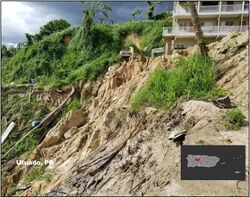Lab-0031
From CSDMS
Revision as of 17:41, 3 May 2023 by Jamy2 (talk | contribs) (Created page with "{{Labbasics |Labtitle=Data Component Use Case for Landslide Susceptibility Calculation |LabCOModule=1 of 1 |LabDateContributedOrUpdated=2023-05-03 |LabDescriptionShort=A demonstration of how to use the Data Components to download topography and soil datasets to calculate the landslide susceptibility. |LabCODuration=1.5 hrs |LabURLDownloadNotebook=https://github.com/gantian127/landslide_usecase }} {{LabContributorData |LabContributorName=Tian Gan |LabContributorInstitute=...")
Data Component Use Case for Landslide Susceptibility Calculation
Contributor(s)
Tian Gan at INSTAAR - University of Colorado Boulder..
Introduction
Landslide susceptibility is the likelihood of a landslide occurring in an area on the basis of local terrain condition to estimate “where” landslides are likely to occur. This lab demonstrates how to use several CSDMS data components to download topography and soil datasets to calculate the landslide susceptibility for a study area in Puerto Rico when Hurricane Maria hit the island in 2017. (Picture source: https://www.weather.gov/sju/maria2017)
Classroom organization
In this lab, you will learn how to use Topography and ERA5 Data Components to download terrain and precipitation datasets. You will also learn how to use the Landlab components (FlowAccumulator and ChannelProfiler) and the Landlab utility (get_watershed_mask) for watershed delineation and overland flow simulation.
Learning objectives
Skills
Skills
- Learn to use Data Components to download research datasets
- Learn to create landslide susceptibility map
Key concepts
- Landslide Susceptibility
- CSDMS Data Component
Lab notes
This lab can be run on the lab (for educators) and jupyter (for general use) instances of the OpenEarthscape JupyterHub: just click one of the links under the Run online using heading at the top of this page, then run the notebook in the "CSDMS" kernel. If you don't already have a JupyterHub account, follow the instructions to sign up at https://csdms.colorado.edu/wiki/JupyterHub. If you're an educator, you can get JupyterHub accounts for students--please contact us through the CSDMS Help Desk: https://csdms.github.io/help-desk.
Requirements
If run locally, please use the environment yaml file to create a virtual environment and run the notebook (https://github.com/gantian127/landslide_usecase/blob/master/environment.yml).
References

